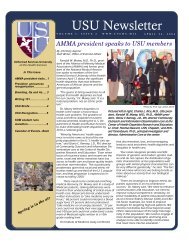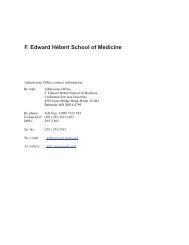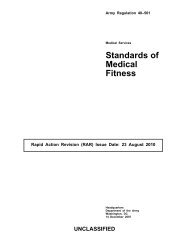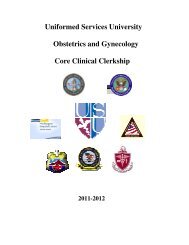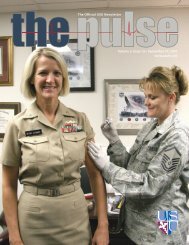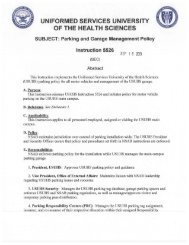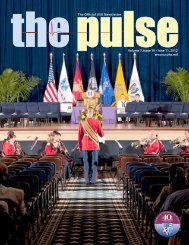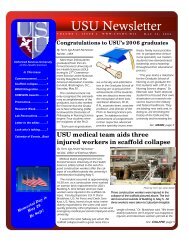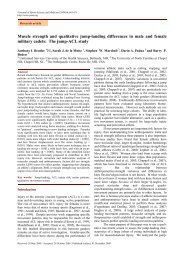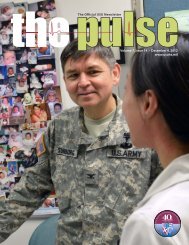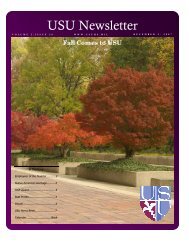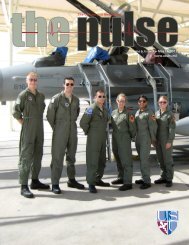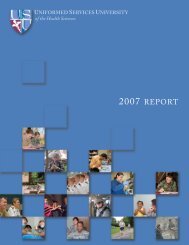USU Newsletter - Uniformed Services University of the Health ...
USU Newsletter - Uniformed Services University of the Health ...
USU Newsletter - Uniformed Services University of the Health ...
You also want an ePaper? Increase the reach of your titles
YUMPU automatically turns print PDFs into web optimized ePapers that Google loves.
2008 Marks 60 Years <strong>of</strong> Military Desegregation<br />
The <strong>Uniformed</strong> <strong>Services</strong> <strong>University</strong> <strong>of</strong> <strong>the</strong> <strong>Health</strong> Sciences (<strong>USU</strong>)<br />
held its alumni weekend May 16 – 17, which provided an opportunity<br />
to reunite after 25 years away from <strong>the</strong> university.<br />
The reunion’s<br />
events started<br />
with campus<br />
tours provided<br />
by <strong>the</strong> Office <strong>of</strong><br />
Alumni Affairs.<br />
During this<br />
time, alumni<br />
Alumni attending <strong>the</strong> 2008 reunion dinner pose<br />
for a picture aboard <strong>the</strong> Capital Elite Yacht. This<br />
was an opportunity for guests to reunite as <strong>the</strong>y<br />
observed historic D.C. monuments from a<br />
unique perspective.<br />
reminisced in<br />
lecture rooms,<br />
met with a few<br />
former pr<strong>of</strong>essors<br />
and were<br />
given an opportunity<br />
to witness<br />
<strong>the</strong> recent growth at <strong>USU</strong> with a tour <strong>of</strong> Building E. Later, graduates<br />
from various years ga<strong>the</strong>red in <strong>the</strong> small dining hall for a Hawaii-<strong>the</strong>med<br />
reception.<br />
The year 2008 marks <strong>the</strong> 60th anniversary <strong>of</strong> President Harry S.<br />
Truman’s executive order 9981, issued July 26, 1948, declaring<br />
that “<strong>the</strong>re shall be equality <strong>of</strong> treatment and opportunity for all<br />
persons in <strong>the</strong> armed services without regard to race, color, religion<br />
or national origin.”<br />
The American military has traditionally been known as a social<br />
motivator and has been regarded as leading <strong>the</strong> country toward<br />
integration/desegregation, yet war time needs seem to be one <strong>of</strong><br />
<strong>the</strong> great motivators toward equalization. Initial efforts <strong>of</strong> integration<br />
were solidified as preparations began for <strong>the</strong> Korean War<br />
(Demographic studies took place before <strong>the</strong> Global War on Terrorism,<br />
so it’s difficult to tell how much <strong>the</strong> current war-time posture<br />
has affected <strong>the</strong> status <strong>of</strong> advancement and utilization <strong>of</strong> ethnic<br />
minority servicemembers.)<br />
Military desegregation began in 1946 and was finally achieved<br />
in 1954 with <strong>the</strong> completion <strong>of</strong> <strong>the</strong> Fahy Committee‘s final report,<br />
"Freedom to Serve.” This was a full decade before <strong>the</strong> US Civil<br />
Rights Act <strong>of</strong> 1964, <strong>the</strong> beginning <strong>of</strong> equal rights in <strong>the</strong> civilian<br />
population.<br />
Evidence <strong>of</strong> <strong>the</strong> military’s continuing interest in equal opportunity<br />
can be found in its many efforts at self improvement over <strong>the</strong><br />
years, as well as in its constant monitoring <strong>of</strong> programs, scrutiny <strong>of</strong><br />
trends in population representation, internal surveys <strong>of</strong> its personnel,<br />
and aggressive approach to management training.<br />
President Franklin D. Roosevelt’s “Four Freedoms” (freedom <strong>of</strong><br />
speech, freedom <strong>of</strong> worship, freedom from want and freedom<br />
from fear) were largely unavailable to African Americans, yet 2.5<br />
million black men registered for <strong>the</strong> military draft. More than one<br />
million eventually served in all branches <strong>of</strong> <strong>the</strong> armed forces during<br />
World War II. In addition, thousands <strong>of</strong> African-American<br />
women volunteered as combat nurses.<br />
Integration took <strong>the</strong> same slow path for o<strong>the</strong>r minorities as well<br />
as African Americans. America’s first Black general <strong>of</strong>ficer was Benjamin<br />
O. Davis, who initially entered <strong>the</strong> Army in 1898 and was<br />
promoted to <strong>the</strong> rank <strong>of</strong> brigadier general 42 years later at <strong>the</strong><br />
age <strong>of</strong> 64. Second- and third-generation Japanese Americans who<br />
joined <strong>the</strong> military were viewed with distrust and assigned to all-<br />
Nisei units.<br />
In 1976, that <strong>the</strong> first Japanese American, Theodore S.<br />
Kanamine, rose to <strong>the</strong> rank <strong>of</strong> a general <strong>of</strong>ficer in <strong>the</strong> Army.<br />
The first Hispanic American to ascend to this level was David G.<br />
Farragut, appointed as an admiral in <strong>the</strong> Navy in 1866 after a brilliant<br />
career during <strong>the</strong> Civil War. It would <strong>the</strong>n take ano<strong>the</strong>r 100<br />
years for <strong>the</strong> next Hispanic American to be appointed as a general<br />
<strong>of</strong>ficer: Richard E. Cavazos, who went on to became <strong>the</strong> Army’s<br />
first Hispanic four-star general.<br />
<strong>USU</strong> Alumni Ga<strong>the</strong>r for 2008 Reunion, Cruise<br />
By Leeann Ori<br />
Alumni Programs Specialist , Office <strong>of</strong> Alumni Affairs<br />
Contributed photo<br />
<strong>USU</strong><br />
After years<br />
apart friends reunited<br />
as if no<br />
time had passed.<br />
Those who were<br />
unable to attend,<br />
provided postings<br />
for <strong>the</strong> memory<br />
board to share<br />
with guests. The<br />
stories ranged<br />
from recent deployment<br />
experiences<br />
to updates<br />
on new additions<br />
to <strong>the</strong>ir families.<br />
Photo by Leeann Ori<br />
<strong>USU</strong> Alumnus Kathy Hall-Boyer, SOM Class <strong>of</strong><br />
1983, is reunited with her fellow alumni who<br />
could not attend <strong>the</strong> reunion with <strong>the</strong> help <strong>of</strong><br />
<strong>the</strong> Alumni Memory Board.<br />
The main reunion event was held aboard <strong>the</strong> Capital Elite Yacht,<br />
which provided graduates with a tour <strong>of</strong> <strong>the</strong> Potomac River while<br />
<strong>the</strong>y ate dinner.<br />
The night was filled with delight as everyone shared stories<br />
while <strong>the</strong>y enjoyed a unique view <strong>of</strong> D.C. Among <strong>the</strong> many<br />
alumni who attended, was <strong>the</strong> School <strong>of</strong> Medicine commandant,<br />
Col. Ken Tashiro, a 1984 SOM graduate.<br />
A Traditional Academic <strong>University</strong> with a Unique<br />
Focus<br />
PAGE 5




